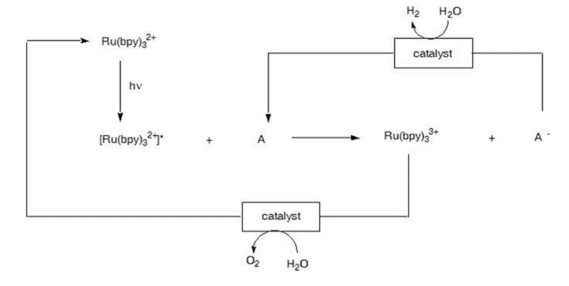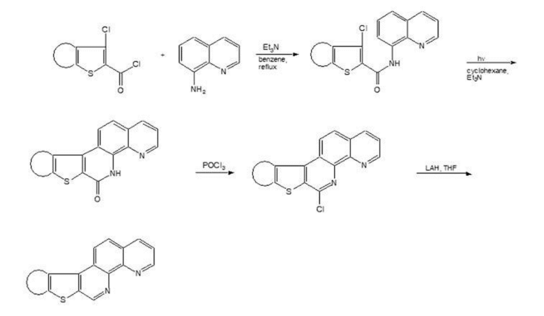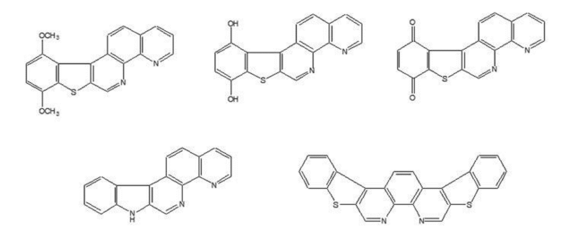
Dr. Lyle Castle
Full Professor
Office: PSC TBA, Pocatello
208-282-7929
Ph.D. Organic Chemistry, University of South Florida, 1992
Research area: Organic Synthesis, Organometallic Synthesis
Student experience required for research: CHEM 111 & 112 and currently enrolled in CHEM 301/303
Student experience gained from research: Synthetic methods, chromatography, 1D and 2D NMR, photochemistry and theoretical methods.
Ideal preparation for: National companies specializing in agrochemical, pharmaceutical, and petroleum. Local companies such as Simplot, AMI, and INL. Also good for pre-medical, pre-dental and graduate schools in science or other areas.
Research Focus
In 1979 a method for breaking water into hydrogen and oxygen using sunlight was reported in the literature. The water-splitting scheme is shown below:

The above scheme shows the potential for generating water through electron transfer processes driven by sunlight. The process shown above does in fact generate hydrogen and oxygen using sunlight. However, the process is so slow that it is not useful. The limiting factor is the lifetime of the initially formed excited state termed the Metal to Ligand Charge Transfer state (MLCT). The shorter the lifetime of this state the less likely the process becomes. Hence, to successfully utilize this approach for solar energy conversion new compounds must be discovered that generate longer MLCT lifetimes.
The research in my laboratory focuses on the synthesis of new heterocyclic compounds containing the 1,10-phenanthrolin moiety for chelation with d-block metals with potential application as photosensitizers for solar energy conversion devices. The aim is to prepare the ligands, their metal complexes and to then measure the wavelength and lifetimes of their MLCT's. Once a variety of such compounds have been prepared and their MLCT's measured the long-term aim would be to begin to develop structure activity relationships where MLCT lifetimes would correlate with specific structural features.
The synthetic scheme currently in place in my laboratory utilizes the photocyclization reaction to construct the 1,10-phenanthroline moiety. The basic synthetic strategy is shown below:

Using this approach, we have synthesized the heterocyclic compounds shown below as well as
their metal complexes: Ru(bpy)2btp+2, Ru(bpy)2ntph+2 and Ru(bpy)2ntpl+2 where bpy refers to
bipyridine.

We are currently in the process of synthesizing these related structures through a modification
of the synthetic scheme shown above.

Finally, all the synthesized compounds will be used to prepare metal complexes for
measurement of their MLCT's.
Recent Publications
"The First Synthesis of bis-Fused 1,10-Phenanthrolines via Double Photocyclization of N,N-Disubstituted o-Phenylenediamine," T.A. Elmaaty and L.W. Castle, Synthesis, 9, 1402-1404, 2006.
"A New Methode for the Synthesis of Indeno[1,2-b]thiophene with Subsequent Ring Exspansion to form Substituted Thieno[3,2-c]quinoline," L.W. Castle and T.A. Elmaaty, J. Heterocycl. Chem., 43(3), 629, 2006.
"Facile Regiocontrolled Synthesis of Trialkylsubstituted Pyrazines," T.A. Elmaaty and L.W.Castle, Organic Lett., 7(24), 5529-5530, 2005.
"Chromate Oxidation of a-Nitro Alcohols to a-Nitro Ketones: Significant Improvement to a Classic Method," T.A. Elmaaty and L.W. Castle, Molecules, 10, 1458-1461, 2005.
"Synthesis and Total 1H-NMR Assignment of [1]Benzothieno[2,3c][1,10]phenanthroline," A.P. Halverson, L.W. Castle, J. Heterocyclic Chem., 33, 727, 1996.
